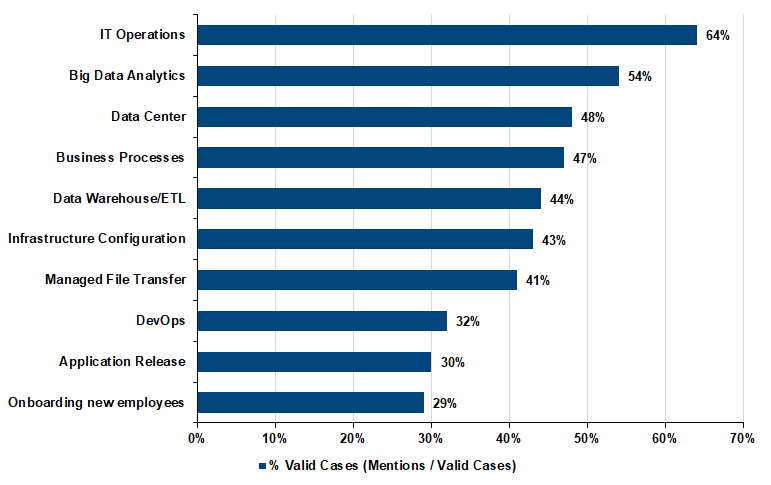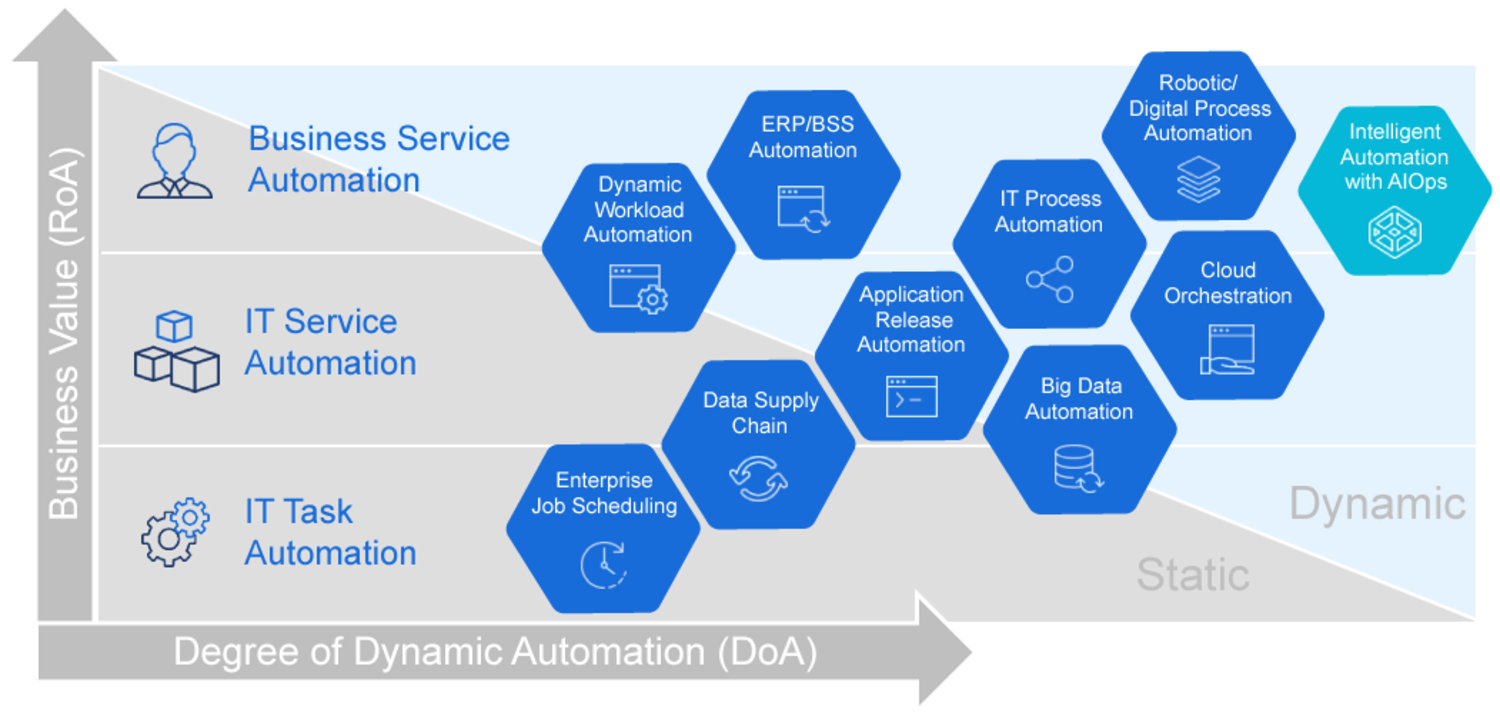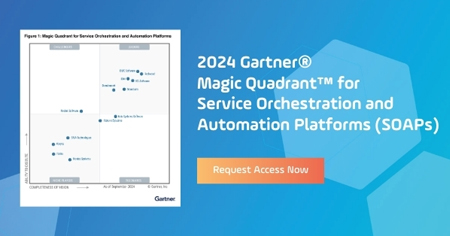Dynamic IT Automation for Telcos, Part 1 - Why & What to Automate?
IT Automation Offers Many Benefits for Telcos (Telecommunications) to Enable and Encourage Digital Transformation.

In this series of articles, we will explore these benefits in more detail, and outline several relevant use cases.
The Domains of Automation
The Automation landscape is flooded with different terms and definitions, each of which indicate different domains and levels of automation. First, let's put them into context:
- IT Operations Automation, which ranges from the automation of batch jobs within IT systems to IT process workflows across many systems. Enterprise-wide Workload Automation tools are increasingly replacing siloed legacy Job Schedulers as a centralized IT automation solution for all types of systems, on-premises or cloud based, including features like secure data transfer and e2e process monitoring and control.
- Business Process Automation, which has evolved from the typical Business Process Management Systems (BPMS) for process flows involving manual human tasks, and IT systems integration into Intelligent BPMS (iBPMS) for supporting analytics/event-driven actions.
- Digital Process Automation (DPA), the emerging space of fully digital process execution, which requires the orchestration of (micro-)services across IT systems, primarily related to enhancing the customer experience. DPA is arguably both a descendant and a subset of BPM/iBPMS. Robotic Process Automation (RPA) is another domain of digital automation, but solely focuses on digitizing routine, manual, desktop tasks on legacy systems not providing an API.
Because the practice is constantly evolving, the very nature of automation requires that the above domains' distinctions are flexible, as implementing automation often crosses domains. What starts as IT process automation can extend to business process workflow, and what used to be static automation may easily evolve to include dynamic, analytics/event/AI-driven actions.
The software tools in the different domains can also have partially overlapping capabilities, and can interact to achieve an increased level of e2e automation in an organization. A BPMS tool can also control a business process wherein some tasks trigger sub IT processes controlled in an workload automation tool, or can even include tasks that need an RPA tool to be automated.
Why Should Telcos Automate Their IT Operations?
While all telecom operators have digital transformation on top of their agenda, their initial efforts are generally focused toward end user interaction with DPA of all processes and touch points in the customer journey. This initiative is crucial for improving customer experience, and by extension increasing loyalty and revenues. But it is also challenging, as it requires that the operator completely transforms both the legacy IT architecture and the business operating model. These transformation programs tend to last years, require a very large investment, and ultimately have a poor success rate, due to their inherent complexity.
At the same time, many telecom operators are surprisingly lagging in terms of internal automation in their core IT Operations. This is unfortunate, given that in contrast to DPA, automating internal IT operations can be surprisingly easy and can reap major benefits quickly and with small investment.The primary benefits of IT operations automation are:
- cost reduction
- productivity
- availability
- reliability
All of these benefits (and more) can be represented as Return on Automation (RoA) - the return businesses receive after implementing some degree of IT automation. IT automation also addresses the challenges organizations face to meet the objectives of the digital transformation in today's complex IT environment. With IT automation businesses can achieve:
- Simplification. Centrally manage all your workload automation across mainframes, enterprise and cloud
- Cloud transformation. End-to-end IT and business process automation across internally and externally hosted resources and cloud services
- Agility. Support DevOps, CI/CD
- Service Level improvement. Increased control with a single enterprise view & automatic recovery in workflows across applications
- Compliance & Security. Audit reporting, secure file exchange
- Efficiency. Synchronization between complex jobs to shorten process lead times
- Service KPIs. Reduce manual interventions & critical outages caused by human error
What Should Telcos Automate?
Other industries boasting large IT operations similar to telcos (banking, insurance, retail, etc.) have long since improved their internal efficiency with IT automation solutions across different domains. These solutions can also easily apply to the telecommunications industry. A few use cases are:
- ERP-related processes (data updates, reports generation etc)
- Data-warehouse processes
- Systems maintenance tasks, backup/archiving, etc.
- Management and control of data pipelines, including data exchange with external partners
- Business continuity (disaster recovery processes)
- Regulation compliance (security audits, GDPR etc)
- IT client/server provisioning
...and more!

Other industries are also leveraging the same software tools to support the digital transformation of their operations. This has lead to an industry-wide increase in the level of IT operations automation driven dynamic, event/data- and progressively AI-based decisions and triggers. Other trends include the implementation of workflows and data pipelines spanning across on-premises and cloud applications, and the use of CI/CD for DevOps.

Telcos can undoubtedly equally benefit from automating IT operations in these ways. There are even telecom-specific operations domains that can significantly benefit from automation. These include the billing process, and TV/media processes and data exchange across the operator, cloud apps, partners and CPEs.
Conclusion
From basic static automation of batch jobs, to orchestrating IT processes across on-premises and cloud applications, to switching to DevOps, and all the way up to event- and AI-driven dynamic automation, telecom operators should set their sights on IT operations automation to achieve quick wins with significant benefits throughout their digital transformation journey.
Stonebranch has worked with over 350 Fortune 1000 Customers in industries such as banking, insurance, manufacturing, retail, media & technology, healthcare, energy, transportation, and the public sector to automate IT operations with optimal Return on Automation (RoA). To schedule a demo, contact us today.
Start Your Automation Initiative Now
Schedule a Live Demo with a Stonebranch Solution Expert





